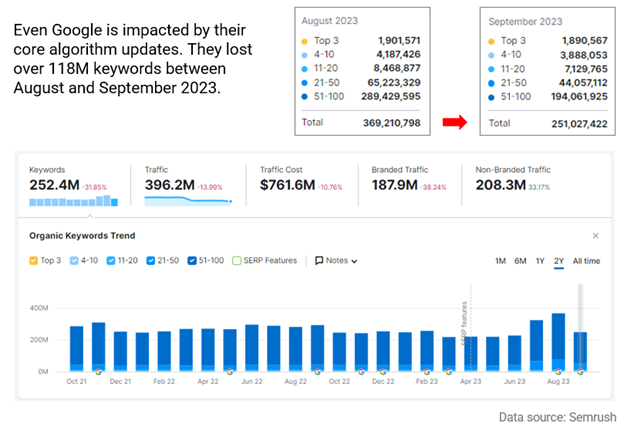 Reading Time: 5 minutes
Reading Time: 5 minutesGoogle has finished implementing its August 2023 Broad Core Update, its second core update of the year. The tech giant started the rollout on August 22, 1:30 p.m. ET, and finished it in 16 days on September 7, 4:03 p.m. ET.
The global update affects all regions, languages, and content types. It doesn’t have penalties, instead, it rewards or promotes high-quality sites and pages. Google Discover and featured snippets are just some of the features impacted by this rollout.
Aside from this core update, Google has made another change. It will show fewer FAQs and HowTo rich results to provide users with a more consistent experience. Only FAQs from authoritative health and government sites will appear in Search Engine Result Pages (SERPs). As of September 13, HowTo results have also been removed from desktop searches, so that markup is now officially deprecated. If you already have HowTo markup on your site, you can safely remove it. If you decide to keep it on the site, due to development priorities, we believe that Google will simply ignore it.
Brands and businesses must keep up with Google algorithm updates because they affect your websites’ performance in SERPs. A core update can positively or negatively impact your rankings and bring changes to your organic traffic and revenue. Vizion monitors these updates and can fine tune content strategies to ensure we’re on the same path with Google’s vision.
What Is a Google Core Update?
Like past Google core updates, the August 2023 Broad Core Update aims to improve search results. Core updates happen several times yearly, marking significant changes to Google’s system and search algorithm. Google’s ultimate mission is to present users with helpful and trustworthy sources, and core updates are a step toward that goal.
According to Google, core updates don’t target specific sites. Pages that didn’t perform well before can gain more visibility after. Meanwhile, pages high up on SERPs pre-update might receive a lower ranking. Core updates help Google determine which sites deserve recognition based on relevance, quality, and credibility.
Because core updates can cause extensive changes in site performance, Google usually announces them before rollout. You can stay updated by checking Google’s Webmaster Central Blog or following their Google Search Central Twitter/X updates. Google will sometimes provide insights on which sites the core update will impact and to what degree it can affect them.
How Can You Tell If Your Site Was Affected by a Google Core Update?
Many companies put a lot of time, effort, and money into optimizing their sites, hoping to find favor with the Google algorithms. But all that can go down the drain with a single core update, and recovering can sometimes take several weeks or months.
If you suspect a core update has affected your site, verify that Google launched one before you get too worried. In this case, Google has confirmed the completion of the August 2023 Broad Core Update in the Ranking section of their Search Status Dashboard. Core updates take several weeks to roll out, and search rankings are often volatile during this period. You would be looking at inaccurate data if you reacted too soon.
Once the rollout is complete, you can check your organic traffic reports as well as Google Search Console. Regardless of your sector, site traffic usually has a weekly pattern. Collect data from the first few weeks after the rollout and compare it to the corresponding weeks prior to the rollout, and to the year prior to account for seasonality. Google Analytics 4 makes this easy by providing a “compare same period last year” feature. You should see a similar trend between the two graphs. If the data for this year shows an abnormal pattern, it might be the effect of the core update.
In addition, perform Google searches related to your business and study the search landscape. Are there changes after the rollout? Are you ranking lower than before? Who is now ranking in your place? It can also help to look at secondary sources of information. You can expect a lot of talk after core update rollouts. While some will be speculation, you can also check reputable sources of SEO news or follow the SEO community on social media to get further insights.
Google themselves are not immune to these updates, when checking their rankings in Semrush it shows that from August to September, they lost over 118M keywords:

How to Recover From a Core Update
According to Google, there may be nothing wrong with your site or page if there’s a decline in its performance after the core update. But it’s hard for business owners to accept this and sit back while their ranking and site traffic have declined.
If you feel like you must fix things, Google’s advice is to concentrate on quality. Ensure your content provides more value in comparison to other pages on SERPs. Instead of copying or rewriting existing sources, build upon your existing content to create something better. It must be original, comprehensive, and insightful. In addition, it should be free of spelling and grammatical errors because even the little details matter. Be sure to check our 10-step guide to enhancing blog content for some great ideas.
Aside from improving content quality, another way to boost SERP rankings is to present your site as a professional and trustworthy source of information. Your content should showcase extensive knowledge of covered topics, giving readers the impression of authority and credibility. Always check for factual errors and show your sources. It also helps to create ‘About’ pages for the site and its authors for added transparency.
Google also likes to prioritize people-first content. It wants you to create content to help readers instead of doing it solely for the algorithm. To do this, you need to determine your site’s primary purpose and a target audience to cater to. Identify their goals and needs and address them through your content. Visitors should leave your site feeling satisfied that they’ve found the answers to their questions and had a great experience.
Performing a site audit can help you pinpoint the areas for improvement. Check which pages were most affected by the core update and see how you can enhance their quality, credibility, and helpfulness. Note that these changes may not immediately translate to better rankings on SERPs. It can take several months for sites and pages to recover from a core update. But Google releases several minor updates yearly that can help with your recovery.
Moving Forward
The August 2023 Broad Core Update is still fresh, and we don’t know the full level of its impact yet. While we learn more about the changes in Google’s algorithm, brands and businesses must be patient and avoid making hasty conclusions. As always, the focus should be on improving the quality of your site and content.




